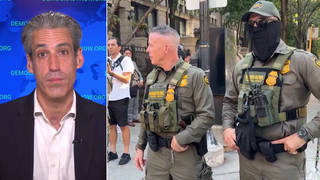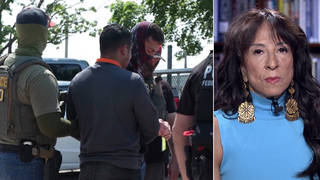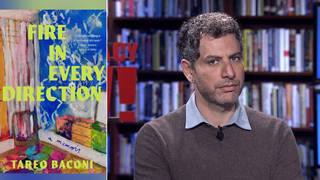
Guests
- John Kiriakouformer CIA analyst and case officer who exposed the Bush-era torture program and was the only official jailed in connection to it.
- Mark Denbeauxattorney for Abu Zubaydah, professor at Seton Hall University School of Law and the director of its Center for Policy and Research.
The Center for Policy and Research has just published a new report titled “American Torturers: FBI and CIA Abuses at Dark Sites and Guantánamo,” which compiles a series of 40 drawings by Guantánamo Bay prisoner Abu Zubaydah that chronicle the horrific torture he endured since 2002 in CIA dark sites and at Guantánamo Bay, where he has been detained without charge since 2006. The United Nations Working Group on Arbitrary Detention has issued a new call for the United States to release him immediately. We speak with one of his attorneys, Mark Denbeaux, and CIA whistleblower John Kiriakou, who exposed the Bush-era torture program and was the only official jailed in connection to it.
Transcript
AMY GOODMAN: This is Democracy Now!, democracynow.org, The War and Peace Report. I’m Amy Goodman, with Nermeen Shaikh.
A warning to our audience: This segment contains graphic descriptions and visual descriptions of torture.
The United Nations Working Group on Arbitrary Detention is calling on the United States to immediately release Abu Zubaydah, who’s been held in U.S. custody since 2002 — for more than 20 years — first at CIA black sites, including in Poland and Lithuania. He was later transferred to Guantánamo, where he has been held without charge. The U.N. body says Abu Zubaydah’s ongoing detention may be a crime against humanity. The CIA has been accused of using him as a human guinea pig by testing torture methods on him, including the practice known as waterboarding, which he endured 83 times, and rape under the pretext of rectal feeding.
The Center for Policy and Research at Seton Hall University has just published a shocking new report that compiles a series of 40 graphic drawings by Abu Zubaydah that chronicle the horrific torture he endured. The drawings include graphic depictions of waterboarding, force-feedings, prisoners being held in boxes, and a practice known as walling.
In a moment, we’ll be joined by two guests, but first let’s turn to the trailer to Alex Gibney’s 2021 documentary, The Forever Prisoner.
UNIDENTIFIED: In 2002, FBI and CIA agents thought they had nabbed a diabolical al-Qaeda mastermind. Abu Zubaydah has never been charged with a crime. He was imprisoned in the secret CIA unit called Strawberry Fields — as in forever.
DANIEL JONES: Prior to 9/11, the CIA never captured or detained anybody. They weren’t prepared.
LAWRENCE WILKERSON: People started looking for who was best to interrogate, and there weren’t any.
UNIDENTIFIED: Psychologist James Mitchell was the only candidate considered.
JOSE RODRIGUEZ JR.: I just took it for granted that they knew what they were doing.
UNIDENTIFIED: The CIA officers were certain he was holding back, because he wasn’t telling them what they wanted to hear.
JOHN RIZZO: Something more aggressive had to be done.
LAWRENCE WILKERSON: The lawyer’s philosophy is, “Tell me what you want to do, boss, and I’ll make it legal.”
JOSEPH MARGULIES: We asked him to draw what was done to him.
UNIDENTIFIED: Abu Zubaydah is put in isolation.
ALI SOUFAN: Everything that was happening was Mitchell’s experiment. Nudity has been approved. Sleep deprivation has been approved. Noise has been approved. The same song again and again and again.
UNIDENTIFIED: He spent 11 days in a coffin-shaped box. He was on the waterboard.
ALI SOUFAN: I mean, this is crazy.
UNIDENTIFIED: The best evidence of what happened is the video.
LAWRENCE LUSTBERG: What was the reason why you thought that it was important to have the tapes destroyed?
JOSE RODRIGUEZ JR.: I needed to protect the people who were there.
JOHN RIZZO: Destroying evidence would inevitably lead to accusations of a cover-up.
JOSE RODRIGUEZ JR.: It would make the CIA look bad.
UNIDENTIFIED: It was an impossible story to tell. So I sued the CIA to get materials unredacted.
UNIDENTIFIED: We saw constant manipulation by the CIA, misleading Bush, misleading Obama.
JAMES MITCHELL: If my boss tells me it’s legal, if the president approved it, I’m not going to get into what some journalist thinks about it.
UNIDENTIFIED: In America, we have this thing called innocent until proven guilty.
LAWRENCE WILKERSON: We were the leaders of the effort against cruel and unusual punishment. After 9/11, that’s out the window.
UNIDENTIFIED: Do the ends always justify the means? Are we prepared to abandon our principles in order to defend them?
AMY GOODMAN: That was the trailer for Alex Gibney’s 2021 documentary, The Forever Prisoner.
We’re joined now by two guests. Still with us, CIA whistleblower John Kiriakou, who was involved in the capture of Abu Zubaydah. Kiriakou was later jailed for almost two years for revealing that the CIA had waterboarded him. We’re also joined by one of Abu Zubaydah’s lawyers, Mark Denbeaux. He is a professor at Seton Hall University School of Law and director of its Center for Policy and Research, co-author of the new report, “American Torturers: FBI and CIA Abuses at Dark Sites and Guantanamo.”
We welcome you both to Democracy Now! John Kiriakou, I want to continue with you. Talk about how Abu Zubaydah was caught and where you were, how you were involved with his capture.
JOHN KIRIAKOU: Sure. Abu Zubaydah was captured in Faisalabad, Pakistan, in late March 2002. I happened to be the chief of CIA counterterrorism operations in Pakistan at the time. And we had been looking for Abu Zubaydah for about six weeks. We finally were able to narrow down his possible location to one of 13 sites. We hit all 13 sites simultaneously at 2:00 in the morning, and he happened to be in one of those sites. I was at a safe house nearby in radio contact with all of our officers who were at the site. And when I say “our officers,” I mean they were teams of CIA, FBI and Pakistani intelligence officers.
Abu Zubaydah was shot when he was trying to leap from the roof of one house to the roof of another to get away. After specifically being told not to fire any shots, a Pakistani policeman shot him anyway and nearly killed him. He was hit three times with an AK-47. We rushed him to a hospital in Faisalabad. They were able to stanch the bleeding as best they could. And then we put him on a helicopter and sent him to a Pakistani military base. He was there for — I think it was 56 hours, in the end, and then put on an unmarked CIA plane and taken to the first of several black sites.
NERMEEN SHAIKH: John, what were you told about why you had to find this man? You said the search went on for six weeks. What did the CIA say they thought he was responsible for?
JOHN KIRIAKOU: Well, I’m smiling, because that is such an important question. What we were told in the very beginning was that Abu Zubaydah was one of the most dangerous and most violent men on the planet, that he was the number three in al-Qaeda, he was one of the masterminds of the 9/11 attacks. And in the end, none of that was true. None of it. The information that we were getting from CIA headquarters, from NSA, from the FBI, it was all erroneous. And so, we thought that this was this terrorist superman that we were after. We literally dropped everything else that we were doing in Pakistan, and we dedicated a virtual army of men and women to tracking his location. But in the end, none of what we believed had any truth behind it.
NERMEEN SHAIKH: Then where was he taken? You said he was taken in an unmarked plane out of Pakistan after being in this military hospital. Where did he go? I mean, just trace his journey. He went to several black sites. And what do you know about what happened at these black sites?
JOHN KIRIAKOU: I am sorry to say that 20 years after the fact, the CIA has never publicly admitted or declassified the locations of those black sites. I’ll defer to Mark on the specific answer, but I will say that the locations of these various sites have been reported on extensively in the media. I just can’t confirm it.
AMY GOODMAN: And before we go to Mr. Denbeaux to talk about not only where he was taken, but these unbelievably horrifying illustrations of Abu Zubaydah, talk about how you came to be aware of what was happening to him — I mean, you were responsible for his capture — and why you decided to go to the media with that, which ultimately led to you being imprisoned.
JOHN KIRIAKOU: Well, you know, I’m a firm believer in a couple of things. I’m a firm believer in respect for human rights, and I’m a firm believer in the rule of law. And if the United States, as a government, as a society and culture, is going to go around the world and impose our professed beliefs on human rights upon every other country in the world, if we are going to have anti-torture laws in our country, if we’re going to be not just signatories to but the drafters of the United Nations Convention Against Torture, then, by God, we have to live by those words. Right? We have to take that seriously. We’re either going to be a shining beacon for the rest of the world on human rights and civil rights and civil liberties, or we’re not. We can’t be both. We can’t tell other countries to respect civil rights, and then ignore — or human rights, and then ignore human rights when it’s inconvenient for us to respect them.
Abu Zubaydah, I think, is the poster boy for that. Here’s a man who we were just simply wrong about. We savaged him in secret. We denied him his constitutional rights to confront his accusers in a court of law. We never charged him with a crime. We know from the Senate torture report that the plan was for him to just die in custody, and then we would cremate him and throw his ashes into the sea. Well, where’s the legal justification, or, frankly, the moral justification, for any of that? Abu Zubaydah, if he was not going to be charged with a crime, should have been released years ago, decades ago. And here we are 21 years later, and he’s still imprisoned.
NERMEEN SHAIKH: Mark Denbeaux, you are one of the attorneys representing Abu Zubaydah, and you’ve just released a report titled “American Torturers: FBI and CIA Abuses at Dark Sites and Guantanamo.” Explain what’s in that report.
MARK DENBEAUX: OK. That report was based exclusively on the drawings that Abu Zubaydah made of the examples of the torture he endured, as well as — and this is significant — his descriptions of each of those events. And the descriptions are something that’s really never been seen or heard. These are the descriptions of the torture victim describing the effect of each torture technique.
Now, as to the significance of the drawings, one reason they’re so significant is it is fully recognized that the CIA had 92 videotapes of his torture, and it’s also recognized that a federal judge ordered the CIA to preserve those for purposes of litigation that would be following. It’s also undisputed that the CIA knowingly destroyed those tapes, in order, as your — the trailer indicated, it would be to hide the people — to protect the people who engaged in that torture. So, there’s no visual evidence of what they did to Abu Zubaydah. There’s only the sanitized descriptions of what types of techniques could be used, most of which were not used the way they would sound. And these drawings are the only source of the — of application of the torture techniques approved by America’s torture program, and they’re done by Abu Zubaydah.
And he is, of course, the first person the U.S. chose to torture. And the U.S. torture techniques were approved solely to torture him, even though they fully knew he did not and was not appropriately — he didn’t warrant any detention. I mean, obviously, the cynical thing is, before the CIA advised the Department of Justice why he should be tortured, the CIA’s reasons had already been learned by the FBI, and the FBI formally told the CIA, “None of these facts are true, and whatever you’re saying is false.” And they proceeded anyway.
AMY GOODMAN: I want to turn to another clip from The Forever Prisoner of James Mitchell, the retired Air Force psychologist who was the chief architect of the CIA’s torture program. You remember Mitchell and Jessen, the two psychologists. It starts with FBI agent Ali Soufan.
ALEX GIBNEY: You call this guy Boris. Is Boris his real name?
ALI SOUFAN: No. I cannot talk about him, and I cannot even mention his real name.
ALEX GIBNEY: This is Boris. His real name is James Mitchell. He also wrote a book about the interrogation of Abu Zubaydah. But Mitchell’s book had the full cooperation of the CIA, because Mitchell was the inventor of EITs, the acronym for what the CIA called enhanced interrogation techniques, and what the rest of the world called torture.
JAMES MITCHELL: If my boss tells me it’s legal, especially if the president has approved it, I’m not going to get into the nuances about what some guy in the basement or what some journalist thinks about it, because they’re free to trade places with me anytime they think they can do a better job of protecting Americans.
AMY GOODMAN: Again, that’s James Mitchell, the retired Air Force psychologist who helped to design the torture program. Mark Denbeaux, if you can talk about his role and the role of the American Psychological Association — a very sordid, dark chapter of the largest association of psychologists in the world — and how this actually was implemented and used against Abu Zubaydah? And then describe in detail — we also have a radio audience — the illustrations, that have rarely been shown, that we are showing today.
MARK DENBEAUX: OK. Let me start with James Mitchell’s claims justifying why he did it. First of all, James Mitchell was hired by the CIA four days after Abu Zubaydah was captured. And the CIA had determined that they didn’t want the FBI or the Defense Department interrogating Abu Zubaydah. They wanted to keep control of him. Then they hired Mitchell. And people asked, “Why are you hiring somebody in order to do this interrogation?” And the CIA director said — or, deputy director, “We are in uncharted waters. We’ve never done this before.” Then Mitchell invented the techniques that he wanted to use, claiming they would work. And after he had the techniques approved, then they needed somebody to torture.
And they created a person to justify torturing him, and that was Abu Zubaydah. That’s because he was the only human being they had captured, the CIA captured. He was also the only human being that they had available to torture. And they created a fictitious person, described previously as an al-Qaeda representative, a leader and so on, and passed that on to the Department of Justice. Department of Justice said, “We’re giving permission to torture him, assuming these facts are true.” In fact, the CIA knew they weren’t true, and, as I’ve said earlier, had been told by the FBI that they weren’t true.
So, Mitchell, in fact, invented the psychological assessment of Abu Zubaydah. That leads us into the Mitchell relationship and also the American Psychological Association. The only document ever presented to the Department of Justice to justify torturing Abu Zubaydah was called a psychological assessment. This was obviously designed by a psychologist. But the one thing missing from the psychological assessment is an assessment. You would think they’d be talking about the impact of it, how harmful it would be, how it might work, the dangers and so on. All it does is list 13 fallacious facts that are dripping with gore, all untrue, to give to the Department of Justice.
So, the Department of Justice was duped into believing they really had the mastermind of 9/11, they had the number two al-Qaeda person, he had been coordinating worldwide terrorist programs and a series of other things. But every single one of those was false, and every single one of them was determined to be false, including by the Senate Select Committee on Intelligence. So, Mitchell fabricated all of the facts designed to justify torturing him. And bear in mind, he had been interrogated and tortured by Mitchell for five months before they gave the CIA — the Department of Justice this fake description of him. So he invented and fabricated all the facts that allowed them to torture somebody who is now absolutely agreed to have been not any of these bad things that were said about him.
Now, about the drawings, first of all, the drawings are really quite gruesome. And, in fact, quite a few American news media have not been willing to publish the report or the drawings because they are simply too disgusting. I agree they’re disgusting, but, of course, I think that’s exactly why they should be published.
OK, among the drawings — first of all, keep in mind that nowhere did the Department of Justice say you could keep people totally nude for weeks, months and maybe years at a time. That’s — the duration of some of these things is another abuse. Another thing is, when they were talking about anal rape, there’s a discussion in there of think anal rape, with him bending over on his hands and knees, and they have a broomstick pointing to or touching his anus, or near his anus. That’s there. And there are guards sitting, watching that. Then, as you go through some of the waterboarding, they would put him in a water shaped — a coffin-shaped box, lying down, with his hands handcuffed, the water up to his nose. And they would sit there and watch him and then ask — and keep track of him. And then, when he would go under, they’d push him under, they would bring him up. That could go on for hours and days.
One of the things about these drawings is they do not show the duration of the torture. For instance, the CIA cables show for 17 straight days they cycled through each one of these techniques — the walling, the waterboarding, the confined spaces, the detention, hands and knees locked together so they can’t move, the nudity, all of the other things, including hitting and walling. And you mentioned walling. Walling turns out to be probably the most physically damaging of all the torture, because they have a man standing right near a very solid wall, about 18 inches away, with his heels kept from moving, handcuffed, and then they stand there interviewing him and asking him questions, supposedly. And then, every once in a while, they reach up and slam him back, so his body goes back and his head hits the wall. And they will do that over and over and over.
And what they would end up doing is they would do that for quite a while, then they’d have him stand nude in a room, a cold room, and spray water on him for a long period of time. Then they would put him in a very small box, the size of a box where you could only have your knees together, your ankles together — like a catcher in baseball — with their hands, feet and heels all stuck together, in that box, in the dark, for an unknown amount of time. Now, of course, the detainee has no clock, no calendar, no days. They don’t know how long they’re in there. Then they would bring them out, and they would then put them in a larger box. And sometimes they would have them in a larger box, and they would rock the box back and forth while he’s there in the dark knowing what’s happening. And throughout all this time, of course, there was not only the nudity, but loud music, and they were also threatening to desecrate the Qur’an. There’s a drawing showing that.
But, ultimately, the drawings are simply a picture of — if these were the approved torture techniques, and they were all approved, in a sense, then you have the people who were engaging in it being like freelancers, going off and trying to invent other ways to make it work. Nowhere did the prudence say you should take a rape, an anal rape with a broomstick; that was their invention. Mitchell gets credit for that one. And the same thing happened when they were talking about keeping him in water for hours and hours and hours, as he complains he was in there so long, he couldn’t protect himself, and so his body waste ended up — he was in water with his body waste, with his hands and feet shackled, with just his nose out of it, for an indefinite period of time.
So, people have to look at all these pictures. And this is maybe the only place where anybody will ever get to see them. They won’t get to see the CIA videos.
AMY GOODMAN: I want to thank you very much for being with us, Mark Denbeaux. And I want to end with one final quick question to John Kiriakou. You went to jail for 23 months. Would you do it again to expose what happened to Abu Zubaydah, going to the media and revealing this?
JOHN KIRIAKOU: In a heartbeat. I would do it again today. And I’ll tell you the truth, Amy. My only regret is that I didn’t go far enough all those years ago. I should have been more clear. I should have ignored nuance. I should have just come out with everything. I would do it again in a heartbeat.
AMY GOODMAN: John Kiriakou, CIA torture program whistleblower, worked at the CIA for over a decade. Mark Denbeaux, lawyer for Abu Zubaydah, Seton Hall professor, we’ll link to your new report, “American Torturers: FBI and CIA Abuses at Dark Sites and Guantanamo.”
Coming up, the CEO of the company behind ChatGPT warns Congress about the dangers of artificial intelligence. Stay with us.
[break]
AMY GOODMAN: Prominent Sudanese singer Shaden Gardood was killed in crossfire between the Sudanese army and the paramilitary Rapid Support Forces in Omdurman City Friday, despite an agreement between the two warring sides to protect the civilians. Hundreds and hundreds of civilians have died.










Media Options